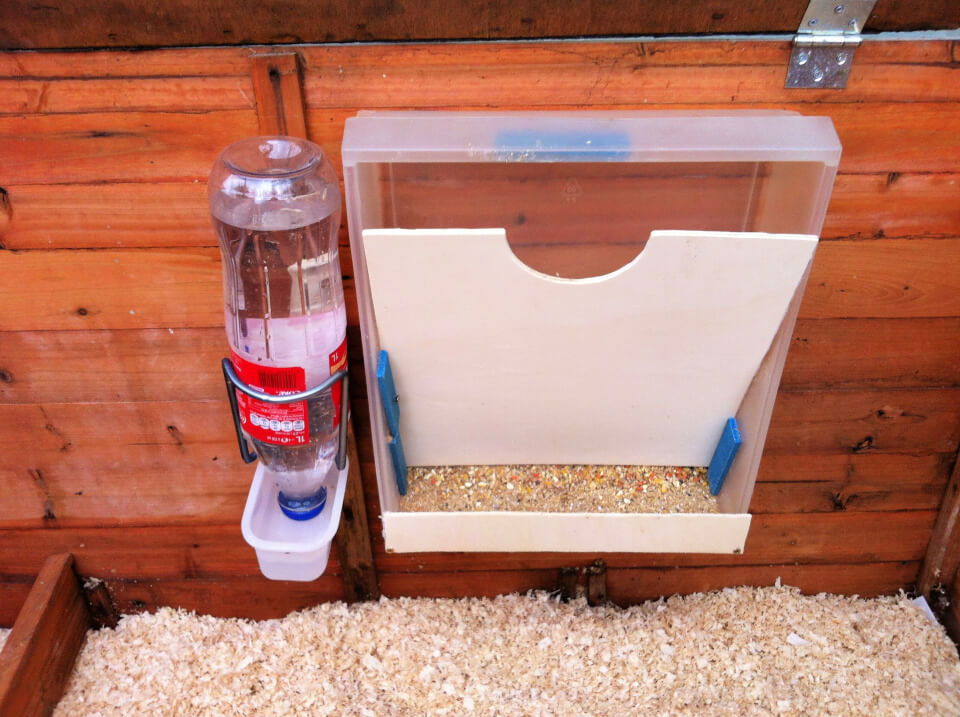

Another option is to move chicken feeders indoors overnight and place them back outside during the day. Some chicken keepers prefer to place feeders indoors for more control, while others build a sheltered spot with a dedicated run for outdoor feeding. Chicken feed kept outside is also more prone to pilfering by birds and rodents, and can even attract poultry predators like raccoons and weasels. And free-range chickens produce the tastiest, most nutritious eggs.īut outdoor feeders need to be waterproofed or otherwise sheltered from the elements.
Chicken feeder diy free#
Outdoor feeders free up space in the coop and get the hens outside and into the fresh air. It also encourages your chickens to spend less time outdoors, which means the litter in the coop will need to be cleaned more often. However, if your coop is on the smaller side, an indoor chicken feeder takes up precious space. Wet feed will become moldy and spoil quickly. Indoor feeders have the benefit of keeping the food dry in rainy or snowy conditions. Chicken Feeder Placementĭo you plan on keeping the chicken feeder inside the coop or outside in the run? Each has its advantages and drawbacks, and the design of the feeder should be planned accordingly. If some chickens aren’t receiving enough food, add more chicken feeders to the coop. Observe your hens at feeding times after introducing a new feeder system to the brood. Dominant birds may prevent those lower in the pecking order from feeding, curious hens may knock over the container, and some chickens just like to make a mess of the whole thing.Īn unruly or large flock would benefit from two or more medium-sized feeders to ensure all chickens get their due. The character of your hens will have an impact on the size and style of the chicken feeder too. As a very general guideline, each chicken should have about 2 inches of feeding space. It should be large enough not to need constant refilling, but small enough that the feed doesn’t spoil before it has a chance to be eaten.Īnother thing to bear in mind is how the chickens access the feed. The size of the feeding vessel(s) should hold enough food for all your chickens. Each egg-laying hen needs roughly ¾ of a cup of food per day, or about a ¼ pound. How many chickens you keep will determine the size of the chicken feeder you build. Not all chicken feeders are created equal and should be adapted to fit your coop’s specific needs.īefore committing to a design, consider: The Flock The amount of decline in egg-making is directly related to the amount of time the flock went without.Ĭlearly, keeping your hens well-fed and watered is vital for healthy, happy, and productive chickens! Considerations When Choosing a Chicken Feeder Design The best egg production occurs when chickens receive at least 16% protein in their feeds, as well as access to fresh, clean water at all times.Įgg production stops or slows when hens run out of feed or water for several hours at a time. Keep them well-fed with a DIY chicken feeder.Įgg-laying hens require a balanced diet that includes energy, protein, and calcium. This means that chickens are almost always hungry and food obsessed. If your flock and coop are larger, you might consider building two feeders to accommodate all of your hungry beaks.DIY chicken feeders have come a long way from the old trough-style feeders.īecause chickens have a narrow intestinal tract, they like to eat often but in small portions. For my modest flock of eight, one feeder is plenty. It’s already paying for itself in the amount of feed we’d otherwise spoil in crop circles or that we’d lose to wild birds. The chickens and I all love our new PVC feeder. Seasonal changes might affect the success of this type of feeder or just necessitate a little ventilation, but so far it’s working great and there are no signs of problems. (I’ll clean the feeder this way on a monthly basis even without problems.) Then I’ll put a vent cap for the top of the feeder to let air in and allow moisture to evaporate, while protecting the inside from rain. If I find any evidence of mold or fermenting feed, I’ll empty the feeder, clean it with vinegar and let it air dry. We haven’t had any trouble with mold or with smelly, fermenting feed.

However, because our feeder is short and because the chickens eat voraciously, feed is always moving down and out. Because we haven’t permanently sealed the feeder with plumbing adhesive and it’s outside the coop, it can get a little damp inside during hard rain. The beauty of this feeder is its simplicity, though it’s not perfect: A PVC feeder can be prone to condensation inside. Our feeder has about 2½ feet of pipe to fill, which holds a little more than half the amount of feed that the traditional feeder holds. Then I filled the feeder with their regular crumble. I was worried about chicken feed becoming compacted in the bottom of the feeder, so I poured oyster shell grit to just below the level where the chickens will be eating.


 0 kommentar(er)
0 kommentar(er)
